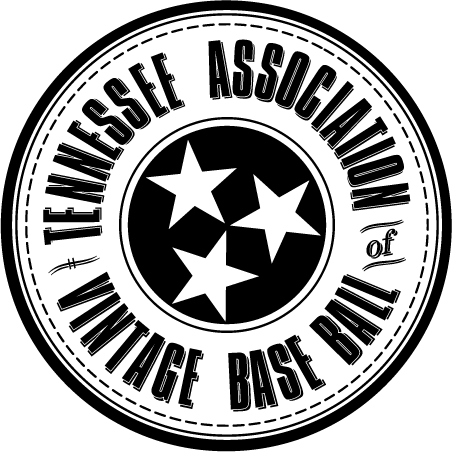I’VE WATCHED BASEBALL FOR YEARS. WHAT’S DIFFERENT ABOUT VINTAGE BASE BALL?
Vintage base ball (two words) is a reflection of how baseball (one word, the modern game) existed at an earlier time. Here are some of the main differences from modern baseball:
- The cover of a vintage ball, called a lemon-peel, is made from one piece of leather rather than two and stitched in a cross pattern. The ball is wound less tightly than a modern baseball and is slightly larger.
- There was no restriction on bat size except a 2.5” diameter on the barrel. The bats we use show a range of different styles from the late 1800s.
- The pitcher throws the ball underhanded from 45 feet away, and his or her job is to deliver the striker a hittable ball. Called balls and strikes were introduced gradually throughout the 1860s in order to increase the pace of play.
- No gloves are used; the catcher and fielders play with bare hands. Two handed catches are the most common, but one handed catches will be occasionally used to draw cheers from the throng. Gloves, mitts, and other protective equipment didn’t make an appearance until the 1870s and weren’t commonly used until the 1880s.
- Before 1865, a batted ball caught “on the bound” (one bounce) caused the batter to be out. For the other baserunners, catching the ball on the bound allows them to advance in the same way as a ground ball. In 1865 the rule was changed to require the ball to be caught on the fly.
- There is no over-running of first base. If a striker running to first runs off of the bag, he is then considered a baserunner and may be tagged out.
- Unlike modern baseball, the home team doesn’t always bat in the bottom half of an inning. Who bats last is determined by the umpire throwing a bat between the team captains. Whoever grabs the knob of the bat chooses the order of first offense or defense.
- The field is the same size and shape as the modern game, but bases are 12” square. Home plate is a 12” painted white disc. First and third bases are half way into foul territory. A line is drawn parallel to the pitchers point through home plate; hence the umpire’s call, “striker to the line.”
- The umpire is often called the “umpire,” and he usually positions himself behind and to the side of the striker. He is to loudly announce foul balls and balks, assess fines for ungentlemanly behavior, and request the input of the crowd if a close play is in dispute.
- After the first inning, the first striker up isn’t necessarily the next player in the order. Instead, he is the player following the last man who made an out in the previous inning.
- A striker hit by the ball is not awarded any base.
- No infield fly rule. A player may intentionally drop a ball to begin a double play
- In the early years of baseball, base-stealing was common, but sliding in the modern sense was not.
- Ungentlemanly behavior, such as spitting or cursing, was subject to a fine by the umpire.
ARE YOU FOLLOWING THE 1864 RULES TO THE LAST JOT AND TITTLE?
No. We’ve made some changes to the way we play to account for differences in skill level and for the sake of inclusion. Here are some things you’ll see that you wouldn’t have in 1864:
All club members will bat in the lineup.
The rules of 1864 do not allow for player substitution. For the sake of resting our volunteer players, we will substitute men in the field as needed between innings.
While stealing is not a part of our game, we do allow for a one stride lead off of bases.
The official rules require a full nine innings of play for each game. If the team that is supposed to bat in the bottom of the 9th inning is ahead, the game will be declared over at the end of the top of the 9th inning.
WHY THE 1864 RULES?
The rules of baseball were first set down by Alexander Cartwright and his fellow ball players of the New York Knickerbockers Base Ball Club in 1845. Changes to the rules began immediately and change to this day.
Many revisions were published over the years, and due to the nature of communication in the 19th century, rules were different from location to location. For our program, we use the rules as set out in the 1864 edition of Beadle’s Dime Base-Ball Player.
In 1865, the bound rule was eliminated for fair fly balls. In later years the rules were changed to reflect a more skilled game, eventually leading to professional teams like the 1869 Cincinnati Red Stockings.
ARE YOU THE ONLY GUYS THAT DO THIS SORT OF THING?
Hardly. Currently there are over 400 teams in the United States and Canada. Many of the clubs are associated with historic villages or living history programs.
Old Bethpage Village Restoration in Bethpage, New York played their inaugural 19th century base ball contest in 1980. Around the same time the Ohio Village in Columbus started a 19th century base ball program. The Vintage Base Ball Association was founded in Ohio in 1996 and preserves and perpetuates the game of base ball as it was played during its formative years.
The Tennessee Association of Vintage Baseball’s member clubs are members of the VBBA.
THIS IS THE GREATEST THING I HAVE EVER SEEN. HOW CAN I PARTICIPATE?
Ballists need to have a respect for the game, a love of history, and a gentlemanly attitude. The Tennessee Association of Vintage Base Ball does not discriminate against any person regardless of gender, age or race. All skill levels are encouraged.
For those who miss out on these roster spots, the best chance to play in the future is to volunteer now. We are always in need of umpires, scorekeepers, concession assistants, or historic interpreters and demonstrators, and these people are given first preference when roster spots become available. If you are interested in volunteering please reach out to us on social media.
IF A SPECTATOR CATCHES A FOUL BALL, CAN HE OR SHE KEEP IT?
No. In fact, in the vintage game, only one ball was used throughout the entire game, and was given as a trophy to the winning club.
DID WOMEN PLAY BASE BALL IN THE 1860S?
Absolutely, but co-ed teams are a more recent innovation, and one we heartily endorse.
THOSE ARE COOL BATS. WHERE CAN I GET ONE?
The Smacker Bat Company of Murfreesboro, Tenn. is the official bat supplier of the Tennessee Association of Vintage Base Ball.
CAN WE TAKE PICTURES OF PLAYERS?
Absolutely. Just one moment, let me put more pomade in my beard.
YOU GUYS ARE PRETTY OLD, ARE YOU SURE YOU’RE OK TO PLAY THIS GAME?
By scheduling our games weeks apart, it allows each club member to go to the 15-day disabled list after every game.














